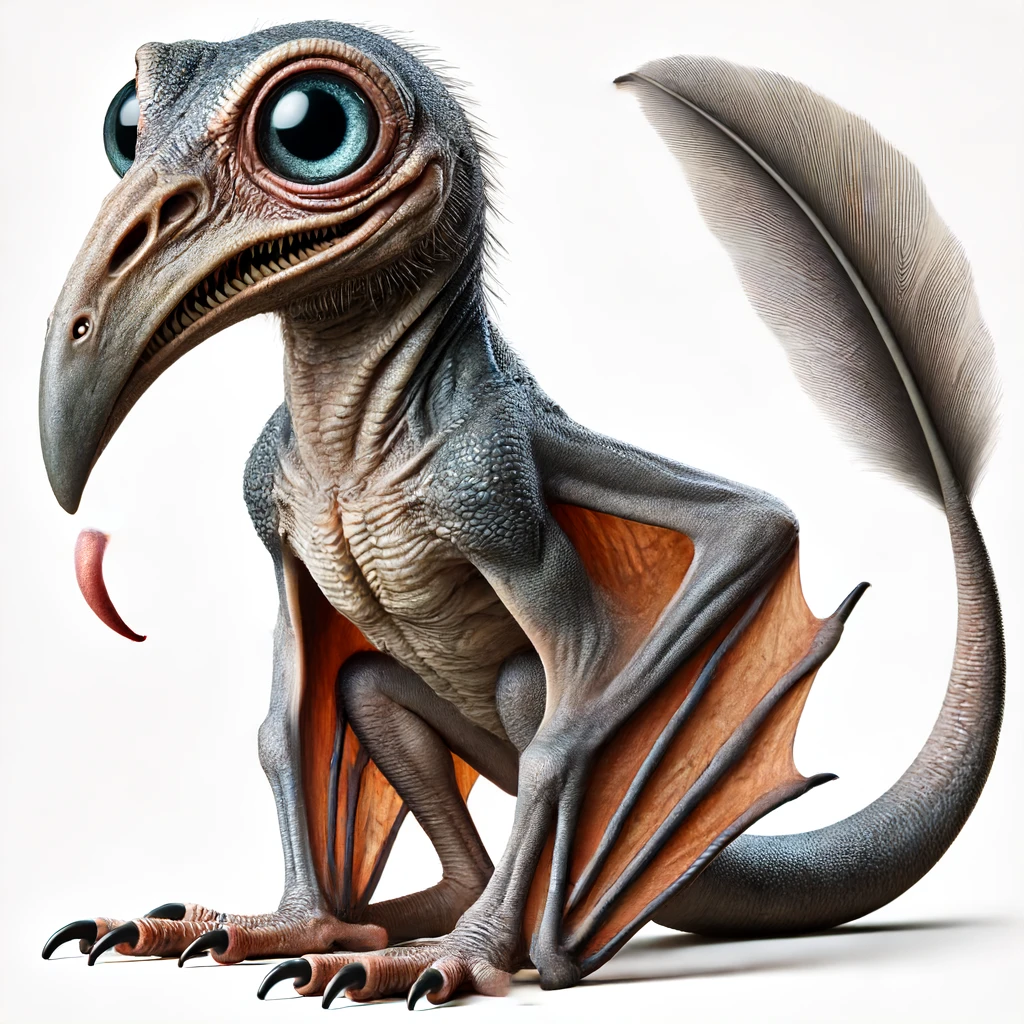Taxonomy:
- Kingdom: Animalia
- Phylum: Chordata
- Class: Reptilia
- Order: Pterosauria
- Family: Gryphidae
- Genus: Pterosauravus
- Species: P. gryphus
Description:
Pterosauravus gryphus, commonly known as the Ptero-Griff, is a fascinating creature that combines features from avian, reptilian, and mammalian species. Its distinctive appearance includes a blend of anatomical traits that make it a unique subject of study in the field of evolutionary biology.
- Head: The Ptero-Griff has a large, rounded head with expressive, oversized eyes that give it an endearing yet predatory look. Its head closely resembles that of a pterosaur, equipped with a sharp, curved beak ideal for hunting and scavenging.
- Body: The body is robust and muscular, covered in a mix of smooth, reptilian scales and fine, down-like feathers. This combination suggests an adaptation for both agility and strength, allowing the Ptero-Griff to thrive in various environments.
- Wings: The creature’s wings are leathery and bat-like, attached to powerful forelimbs. These wings enable it to glide rather than engage in powered flight, indicating a primarily terrestrial lifestyle with the ability to make short aerial maneuvers.
- Forelimbs: The forelimbs feature strong, clawed digits similar to those of a predatory bird or small dinosaur, facilitating effective grasping, climbing, and manipulation of objects.
- Tail: A long, flexible tail with a feather-like structure at the tip aids in balance and agility. The tail may also serve in communication or display behaviors within its species.
- Other Features: The Ptero-Griff has a small, protruding tongue, suggesting a varied diet that may include insects, small animals, and possibly fruits or vegetation.
Habitat and Behavior:
Pterosauravus gryphus is indigenous to the dense forests and rocky terrains of the British Columbia Sector Overview A Sector, commonly referred to as a Provincial Sector, is a designated area of space within the broader and diverse cosmic region known as the Canadian Expanse. These Sectors function similarly to provinces, contributing to the organization and governance of this vast territory. Structure and Division The Canadian Expanse is divided into thirteen Provincial Sectors, each with its own... More and the Nunavut Sector
Overview A Sector, commonly referred to as a Provincial Sector, is a designated area of space within the broader and diverse cosmic region known as the Canadian Expanse. These Sectors function similarly to provinces, contributing to the organization and governance of this vast territory. Structure and Division The Canadian Expanse is divided into thirteen Provincial Sectors, each with its own... More and the Nunavut Sector Overview A Sector, commonly referred to as a Provincial Sector, is a designated area of space within the broader and diverse cosmic region known as the Canadian Expanse. These Sectors function similarly to provinces, contributing to the organization and governance of this vast territory. Structure and Division The Canadian Expanse is divided into thirteen Provincial Sectors, each with its own... More. Its large eyes indicate crepuscular or nocturnal activity, relying on keen vision to hunt in low-light conditions. The Ptero-Griff is both a predator and a scavenger, showcasing remarkable adaptability to different environmental challenges.
Overview A Sector, commonly referred to as a Provincial Sector, is a designated area of space within the broader and diverse cosmic region known as the Canadian Expanse. These Sectors function similarly to provinces, contributing to the organization and governance of this vast territory. Structure and Division The Canadian Expanse is divided into thirteen Provincial Sectors, each with its own... More. Its large eyes indicate crepuscular or nocturnal activity, relying on keen vision to hunt in low-light conditions. The Ptero-Griff is both a predator and a scavenger, showcasing remarkable adaptability to different environmental challenges.
- Diet: The Ptero-Griff’s diet is diverse, ranging from insects and small mammals to fruits and vegetation, reflecting its opportunistic feeding habits.
- Behavior: Known for its excellent sense of smell and hearing, the Ptero-Griff is a skilled hunter despite its relatively poor vision. It can be domesticated and trained for hunting, making it a valuable companion for hunters in its native regions.
Domestication and Use:
The Ptero-Griff has been domesticated by local inhabitants for use in hunting parties. Its keen senses and agility make it an effective partner in tracking and capturing prey. While generally tame when raised in captivity, wild Ptero-Griffs can be aggressive and territorial.
Conservation Status:
Currently, there is no immediate threat to the Ptero-Griff population. However, ongoing habitat monitoring and conservation efforts are essential to ensure that this unique species continues to thrive in its natural environment.
Research and Studies:
Ongoing studies aim to understand the evolutionary adaptations of Pterosauravus gryphus, particularly its sensory capabilities and dietary habits. Research also focuses on the domestication process and the creature’s role in local ecosystems.
References:
- Smith, J. D., & Wesson, L. (2024). The Ecology and Behavior of Pterosauravus gryphus. Journal of Xenobiology, 15(4), 202-218.
- Johnson, M. T. (2025). Domestication of the Ptero-Griff: A Study in Alien Fauna Training. Alien Fauna Journal, 22(1), 34-45.
- Williams, R. E., & Thompson, K. L. (2023). Adaptive Traits of the Pterosauravus gryphus. Evolutionary Biology Reports, 12(3), 145-160.

